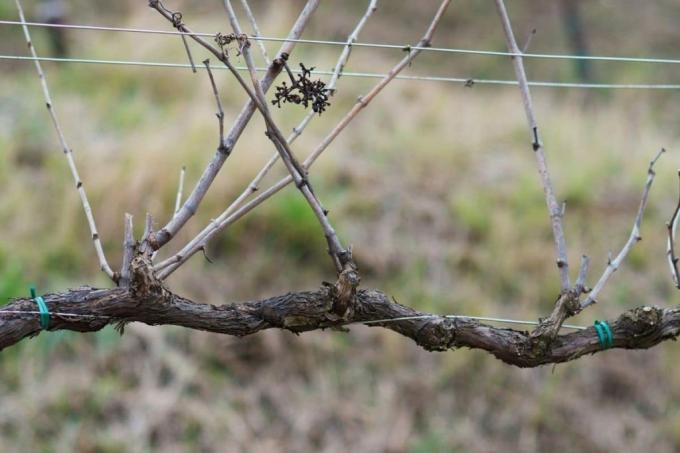
table of contents
- Legal regulations
- Tool for propagation
- time
- Instructions for propagating cuttings
- Instructions for propagating offshoots
- Use blind wood
- frequently asked Questions
Wine is usually very easy to care for, so you can easily propagate it using cuttings. There are a few points to keep in mind when choosing the varieties, especially with regard to the dreaded phylloxera.
In a nutshell
- reproduce mainly varieties that are resistant to phylloxera
- Wine increases in frost-free spring
- Cutting tools should be clean
- it takes about a year before the cuttings can be transplanted
Legal regulations
You cannot propagate grapevines without hesitation in every region. There are legal regulations that state that you can only graft grapevines in wine-growing areas on substrates that are resistant to phylloxera. Hobby gardeners should refrain from propagating cuttings or cuttings in these areas.
In regions that are not part of the wine-growing areas, you can also propagate types of wine using cuttings or offshoots. However, you should also choose varieties that are not susceptible to phylloxera, otherwise an infestation can cause your new vineyard to be destroyed within a very short time.

Note: If vines are propagated in wine-growing regions that are not resistant to phylloxera, and if a large-scale infestation is assumed, high fines are threatened.
Tool for propagation
To use woods for propagation, you should always have a sharp knife close at hand. You will even need one for cuttings because it stimulates the formation of roots if you scratch the bark in one place.
Suitable tools are:
- Finishing knife
- scalpel
- Possibly. Razor blade (only for scratching)
Note: You can use secateurs to cut off cuttings. However, you will squeeze the ends, which slows down the formation of roots, which is why you should always trim the end with a sharp blade.
time
The ideal time to multiply grapevines is early spring. The vines must not be in the juice yet, otherwise they can bleed out. This leads to the fact that on the one hand the mother plant is severely weakened and on the other hand the probability that the cuttings will take root is very low.
The time window is often very small and you should look out for the following signs:
- several weeks without frost
- Buds should be visible
- no leaf formation
In the best-case scenario, the weather is damp, which prevents the cuttings or cuttings. Dry up the sinker in the ground.

Instructions for propagating cuttings
The easiest way to propagate wine using cuttings is to simply stick the twigs in the garden soil. Alternatively, you can use a substrate made from a mixture of peat and sand or you can use commercially available potting soil. If you use pots, you have the advantage that you can choose the location flexibly. Put the cuttings in the garden, choose a partially shaded location. There the soil remains more humid and the risk of the cuttings dying off because they do not have enough moisture is reduced.
Plant cuttings
- Choose strong annual shoots
- Cut the cuttings with 3 - 4 eyes
- Plant cuttings at least 2 eyes deep
- Firmly press the substrate
- Possibly. put a cover over it so that evaporation remains low
Instead of cutting off the cuttings, you can also tear off young shoots. So-called cracks usually form roots more easily than cuttings with a smooth cut edge. However, you should also shorten the cracks at the top to a maximum of four eyes.

Instructions for propagating offshoots
Wine can also be propagated using so-called offshoots. This has the advantage that the sinker is still supplied by the mother plant until the roots are formed. The prerequisite for this, however, is that you can bend a branch down so far that it touches the ground.
Once you have found a suitable branch, proceed as follows:
- approx. Dig a 10 cm deep hollow
- Lower branch
- Use a blade to scratch the part that will later be underground
- Cover at least two eyes with soil
- Fix the shoot tip to an upright stick
Make sure that you keep the offshoot constantly moist. You can separate the shoot from the mother plant in autumn at the earliest. To do this, it is cut off just above the ground with sharp secateurs.
Use blind wood
An alternative to cutting cuttings is what is known as blind wood. These are shoots that kick out directly from the nodular point. You remove the shoots as they weaken the plant, but they are very suitable for making cuttings from them.

However, if you want to propagate over blind wood, cut it off in the fall. Put the branches in a bucket with sand around them for the winter to overwinter frost-free. Only in the following year do you put the blind wood in the ground. In the frost-free spring, plant the blind wood like normal cuttings and proceed in the same way with care.
frequently asked Questions
Yes, make sure that cutting tools are clean to prevent disease transmission.
The root formation takes several weeks. The cuttings should be replanted no later than the following year so that a good root ball has formed.
Cuttings or You do not need to protect the sinkers that are directly in the garden soil from frost. You should protect wine in the pot from frost and make sure that the temperature does not drop below 12 ° C.



